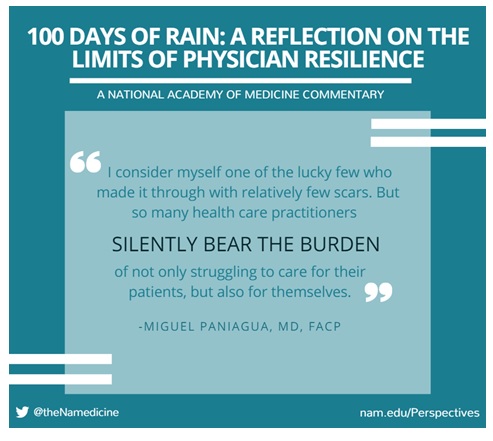100 Days of Rain: A Reflection on the Limits of Physician Resilience
TW: suicide
By January 1999, it rained, they say, for over 100 days in a row; Seattle has a reputation for precipitation, which I have to believe could lead to higher rates of seasonal affective disorder and the need for strong coffee. It was during this month that I can say I may have reached my low point. I was a young, insecure, and nervous intern in the Harborview Medical Center intensive care unit that month—one in which our attending physician later admitted was the busiest of his long career. Myself and my senior resident, Phil, came to expect the admission of more than 10 critically ill patients every fourth night.
The idea of caps on resident duty hours has been studied and discussed since the early 1970s, and even in 1999 the 80-hour workweek was implemented, if not necessarily followed. But caps were not a term we used on-call—they were what our surgical colleagues wore in the OR (operating room), and what I wore on the rare off day I could attend a Mariners game.
Despite a deep-seated feeling that I was an imposter in such a well-regarded training program, I was always a relatively happy-go-lucky guy, who tended to be a shoulder to cry on rather than the one who might suffer from burnout. When two of my peers committed suicide in medical school, or when residency colleagues simply left the field, it seemed at the time more like the “cost of war” than a symptom of a bigger problem. But I was fortunate to feel reasonably well adjusted to the rigors that commenced at the beginning of my residency. I felt that 6 months in, I was hitting my stride. And then I hit a brick wall. Looking past recommended admission limits and duty hours was almost a sign of unspoken stoicism among our peers. I remember seeing a fellow resident during his on-call day on rounds being pushed around in a wheelchair, refusing to go home, with a 103° fever and rigors.
One evening, on our 12th admission for the night, I was in the emergency department taking the history of a woman with pneumonia and sepsis. While conversing, I must have dozed off, because my history and physical read less like an HPI (history of patient illness) and more like an atrial flutter rhythm strip. Phil sent me off to bed, visibly annoyed, and seemingly exhausted himself. He proceeded to admit two more patients alone that night. The day after our post-call day, I was driving to work, completely dejected. I thought to myself that if I got into a moderately severe car accident, then maybe I would not need to go into rounds in the ICU (intensive care unit) for a while. The notion of getting up at 4:00 a.m. to endure 8 hours of doing rounds in what seemed like an endless hallway of critically ill patients every day was getting harder and harder to bear.
Looking back now, it is clear I was depressed. I was fortunate during this time to have a companion (later to become my wife) who became a confidante. “I was a bad doctor today. I missed an important finding” or “I was a good doctor today—I relieved someone’s suffering.” These exchanges were followed by a therapeutic discussion [2]. Since that time, I have embarked on a career in academic medicine, serving in roles as a director of medical school courses and residency programs. I now work for an assessment organization that is in itself a great source of stress for trainees. Examinations in medical school that help in residency placement and licensure are, for better or worse, a rite of passage [3].
The effects of burnout and depression on medical trainees are growing. Awareness and efforts in response to these disturbing trends are thankfully increasing. I firmly believe there was nothing about working to exhaustion, admitting excessive amounts of patients, or working while impaired that ever made me a better doctor. I consider myself one of the lucky few who made it through with relatively few scars. But so many health care practitioners silently bear the burden of not only struggling to care for their patients, but also for themselves.
Download the graphic below and share it on your social networks!
Notes
- Miguel Paniagua is a member of the Global Forum on Innovation in Health Professional Education of the National Academies of Sciences, Engineering, and Medicine. For more information about the forum, visit nationalacademies.org/ihpeglobalforum.
- McKenna and colleagues (2016) propose that “connection to colleagues, patients, and profession is fundamental to medical learners’ resilience, highlighting ‘social resilience’ as a key factor in overall well-being.”
- NBME is looking for individuals to participate in a task force focusing on physician wellness and burnout. If you are interested, contact Miguel Paniagua at MPaniagua@nbme.org
References
- ACGME (Accreditation Council for Graduate Medical Education). 2016. History of duty hours. Available at: http://www.acgme.org/What-We-Do/Accreditation/Clinical-Experience-and-Education-formerly-Duty-Hours/Historyof-Duty-Hours (accessed December 5, 2016).
- McKenna, K. M., D. A. Hashimoto, M. S. Maguire, and W. E.T. Bynum. 2016. The missing link: Connection is the key to resilience in medical education. Academic Medicine 91(9):1197-1199. https://doi.org/10.1097/ACM.0000000000001311
- Shanafelt, T. D., L. N. Dyrbye, C. P. West, and C. A. Sinsky. 2016. Potential impact of burnout on the U.S. physician workforce. Mayo Clinic Proceedings 91(11):1667-1668. https://doi.org/10.1016/j.mayocp.2016.08.016


